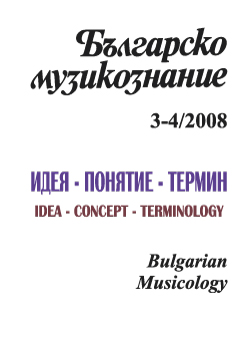Терминът хармония – сфери и модуси на изява в Античността и Средновековието
The Term "Harmony" – Spheres and Modes of Its Appearance in Antiquity and the Middle Ages
Author(s): Mariyana BulevaSubject(s): Music
Published by: Институт за изследване на изкуствата, Българска академия на науките
Summary/Abstract: From antiquity up to the present day, the concept of harmony has not lost its importance both in the fields of philosophy and theology, as well as in its capacity as a term in music theory. The meaning of the term „harmony“ can be captured by the following four elements of a single synthesized definition: 1) harmony is unity in multiplicity – a characteristic of every whole; 2) the harmonic whole is formed from elements that are different either quantitatively or qualitatively; 3) they are arranged in a relationship understood as proportion, order, mutuality, and correspondence; 4) harmony is related to the idea of beauty and perfection. Unity is not always implied by the term „harmony;“ however, the idea of harmony can always be sensed when the thought of unity takes on an axiological sound. Throughout the life of the term „harmony,“ four intellectual spheres for its appearance can be identified: philosophy, in which harmony is the ontological foundation of the world; philosophical propaedeutics, which includes the science of harmony (music) among the four mathematical disciplines; ethics and the theory of education, which includes the idea of musical ethos; and music theory, in which „harmony“ is taken to mean the pitch-height relationships. Theology also retains the concept of harmony, but imbues it with a new meaning as the appearance of the Divine Energy that maintains unity in the world. Hellenic and medieval music theory tracts have given us a multitude of definitions of the concept of harmony, offering rich material for its historical contemplation.
Journal: Българско музикознание
- Issue Year: 2008
- Issue No: 3-4
- Page Range: 24-41
- Page Count: 18
- Language: Bulgarian
- Content File-PDF

